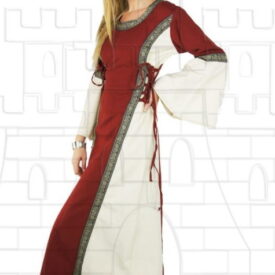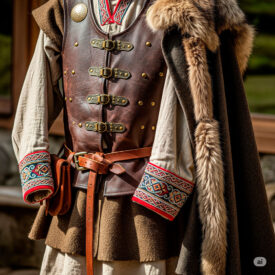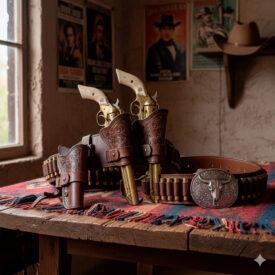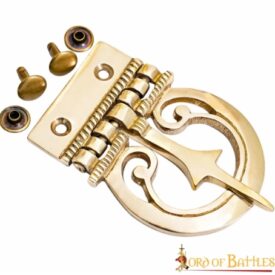The Dybäck Viking Sword: A Weapon with Soul and Legend
\n
What makes the Dybäck Viking Sword so fascinating? More than a piece of iron, the Dybäck encapsulates the confluence of technique, art, and status in Northern Europe around 1000 AD. Its ornamentation, proportions, and the quality of its forging make it a silent witness to an era of voyages, battles, and cultural contacts between Scandinavia and England.
\n

\n
In this article, you will discover the historical origin of the sword, why its ornamentation is key to understanding Northern cultural relations, how these characteristics are translated into modern replicas, and what to look for if you are interested in a faithful and responsible reproduction. I will guide you from the original find to the technical specifications and maintenance that ensures a replica endures as a collector\’s item.
\n\n
Dybäck: Discovery and Historical Context of the Sword
\n
The history of the find in Dybäck (with spelling variations like Dyback or Dybek) provides geographical and cultural context: during the Viking Age, this region of southern Scandinavia was closely linked to the Danish kingdoms and maintained intense contacts with the British Isles. The sword found in a peat bog towards the end of the 19th century stands out for its dating around 1000 AD, placing it at the end of the Viking Age and within the typology of fine swords identified by Petersen as Type Z.
\n\n
| Era/Date | Event |
|---|---|
| 8th–11th Centuries | Development of the Winchester Anglo-Saxon style; characteristic ornamentation with bird, snake, fantastic creature, and intertwining tendril motifs. |
| 10th–11th Centuries | Classification according to Petersen: Type Z; typical chronology of this type of swords. |
| Late 10th – early 11th Century | Period of active contact between Scandinavian nobility and England; it is believed that the hilt may have originated in England or been strongly influenced by its metalwork. |
| c. 1000 AD | Approximate dating of the original sword, placing it towards the end of the Viking Age. |
| c. 1870 | Discovery: the sword was unearthed in a peat bog in Dybäck. |
\n
What does its ornamentation tell us about power and cultural networks?
\n
The decoration of the hilt with intertwined birds, snakes, and tendrils is not mere aesthetics: it is a visual language. This ornamental repertoire is related to the well-known Winchester Anglo-Saxon style (8th–11th centuries), which suggests an exchange of artisans, commercial influences, or the import of prestige pieces. In societies where the sword was not an everyday object but a symbol of rank, a richly worked hilt clearly signaled the social position of its owner.
\n\n
The Weapon as a Symbol
\n
In Nordic culture, gifting or carrying an ornamented sword implied recognition and power. The investment in noble materials — metallic threads, silver, gilding — and the time needed to engrave complex motifs speak of aristocratic patronage or warriors close to the elite.
\n\n
Modern Replicas: Historical Fidelity and Contemporary Solutions
\n
Replicas of the Dybäck Sword seek to reproduce its form, proportions, and decoration while maintaining safety and durability criteria. Modern steels like hardened EN45 or even Damascus steel are commonly used for premium versions. The blade maintains a wide fuller to lighten it without losing strength, and the hilt reproduces the short guard and trilobated pommel of the archaeological mold.
\n
Error: Debes especificar al menos un "categoria_id" o "fabricante_id".
\nConstruction of Replicas
\n
A typical replica features a double-edged blade, a longitudinal groove, a full tang, and a two-piece pommel; the tang is screwed to the bottom of the pommel, and the top cap is fixed with rivets, emulating the traditional system. The scabbard is usually made of wood covered in leather, adorned with aged brass pieces at the mouth and chape.
\n\n
Materials and Performance
\n
– Blade: Hardened EN45 or Damascus in high-end versions. – Hilt: Wood or brass core, wrapped in brass/copper wire. – Ornaments: Brass or silver plating to emulate the original finishes. These decisions balance visual authenticity and mechanical resistance.
\n\n
Comparative Table: Original Sword vs. Modern Replicas
\n
| Attribute | Original Sword (Dybäck) | Typical Modern Replica |
|---|---|---|
| Dating | c. 1000 AD | 21st Century, historical reproduction |
| Blade Material | Forged steel (historical variations) | Hardened EN45 or Damascus steel |
| Hilt | Decorated with gold threads and engraved motifs | Brass/copper wire, brass finishes |
| Guard and Pommel | Silver plated with gold in preserved parts | Aged brass finish |
| Scabbard | Wood and leather (preserved fragments) | Wood covered in leather with brass mouth and chape |
| Weight | Estimated based on remains: light and balanced | ~1.1 kg without scabbard; ~1.7 kg with scabbard |
\n
Dimensions, Balance, and Practical Use
\n
Modern replicas tend to respect the measurements that favored one-handed handling: total length close to 92 cm, blade around 74 cm, thickness 4 mm, and a center of gravity located approximately 12.5 cm in front of the guard. This balance allows for fluid cuts and maneuverability in one-handed combat, although current replicas usually come unsharpened for safety.
\n\n
Typical Specifications
\n
- \n \t
- Total Length: ~92 cm.
- Blade Length: ~74 cm.
- Blade Thickness: ~4 mm.
- Grip Section: ~9.5 cm (total handle ~18 cm).
- Weight: ~1.1 kg without scabbard; ~1.7 kg with scabbard.
- Center of Gravity: ~12.5 cm in front of the guard.
\n \t
\n \t
\n \t
\n \t
\n \t
\n
\n
Forging, Decoration, and Goldsmithing Techniques
\n
The Dybäck sword combines metallurgical knowledge with exquisite goldsmithing. The groove or fuller is a technical decision to reduce weight without sacrificing rigidity, and the hilt\’s decoration requires metal carving and the insertion of metal threads that, in the original, could have been gold or silver. Current replicas use modern techniques to reproduce these effects, using plating and patinas that simulate the passage of time.
\n\n
Why is the fuller key?
\n
Although often mistakenly called a “blood groove,” the fuller is a structural resource: it reduces mass in the center of the section, maintaining moment of inertia and rigidity. In the Dybäck, a wide fuller favored a light, fast, and flex-resistant blade.
\n\n
Maintenance and Preservation of a Replica
\n
The modern steel used in historical replicas is not stainless. To preserve a replica with a period finish, periodic maintenance is recommended: gentle cleaning, fingerprint removal, and protection with a protective oil. Products like Ballistol or other fine oils recommended for metal tools prevent corrosion and preserve the patina sought by collectors.
\n

\n\n
Basic Conservation Routine
\n
- \n \t
- Cleaning: Use a soft cloth to remove dust after each handling.
- Degreasing: Clean with isopropyl alcohol if there are traces of moisture or sweat.
- Oiling: Apply a thin layer of protective oil to the blade and polish gently.
- Storage: Keep the sword in a dry environment; if the scabbard is leather, check it to prevent accumulated moisture.
\n \t
\n \t
\n \t
\n
\n
How to Identify a Faithful Replica
\n
If you are looking for a replica that respects the essence of the Dybäck, pay attention to several aspects: blade proportions, presence and width of the fuller, tang construction (full or not), material and technique of the handle\’s wrapping, and the quality of the pommel\’s riveting. A convincing reproduction not only copies the silhouette but also attempts to reproduce the original\’s constructive logic.
\n\n
Quick Checklist
\n
- \n \t
- Correct proportions: Balanced blade and handle length.
- Wide and centered fuller.
- Two-piece pommel with visible rivets if the replica imitates the original.
- Handle wrapped with metal wire and faithful ornaments.
- Matching scabbard of wood and leather with mouthpiece and chape.
\n \t
\n \t
\n \t
\n \t
\n
\n
Cultural Context: The Sword in the Hands of the Viking Elite
\n
In late Viking society, the sword ceased to be merely a military tool and became an emblem of the warrior\’s social standing. Richly worked swords, like the Dybäck, would have belonged to members of the elite: local leaders, jarls, or warriors who had gained wealth through warfare, trade, or service to the king. Carrying such a sword meant more than fighting; it meant displaying lineage, alliances, and prestige.
\n\n
Narrative: Imagining the Bearer of the Dybäck
\n
Imagine the owner holding the sword before a day\’s journey: the cold hilt, the inlays gleaming in the firelight, and the murmur of stories about voyages to the western islands. This sword was both an instrument of defense and a measure of honor. That story revives when you contemplate a carefully crafted replica, because the piece materializes a social biography as rich as its technical one.
\n\n
Recommendations for Collectors and Reenactors
\n
– Value the design\’s origin: a replica based on typological and archaeological documentation will have more aesthetic and mechanical credibility. – For exhibition, prioritize faithful finishes and noble materials in the details. – For light reenactment, look for hardened blades but with non-cutting edges and secure, ergonomic hilts.
Legal Aspects and Safety
\n
Before acquiring or transporting replicas, verify local regulations on bladed weapons and remember that even unsharpened replicas can be dangerous if handled carelessly. Keep pieces out of reach of minors and use appropriate scabbards to protect both the sword and people.
\n\n
What distinguishes a premium replica?
\n
Premium versions combine high-quality steel (often Damascus), manual work on the hilt, and finishes by goldsmiths. In these pieces, engraved motifs are reproduced with techniques that provide relief and texture, and the mountings can use higher-quality metal inserts to approximate the original\’s shine and feel.
\n\n
Legacy and Why the Dybäck Matters Today
\n
The Dybäck Viking Sword is not just an archaeological object: it is a bridge between craftsmanship and memory. Its forms and decorations narrate routes of influence that connected Scandinavia with England and other regions. In each replica, that history revives, allowing new generations to understand not only what the weapon was like, but why it had significance beyond combat.
\n\n
Visual Resources and Images for Studying Details
\n
Detailed images of the hilt and pommel help distinguish goldsmithing techniques and stylistic patterns. Observe the wrapping of the handle, the curvature of the guard, and the trilobated shape of the pommel to recognize the Type Z typological affiliation.
\n\n
Practical Technical Comparison for Buyers
\n
| Element | What to observe | Why it matters |
|---|---|---|
| Blade Material | Hardened EN45 or Damascus | Determines durability, flex response, and aesthetics |
| Tang Type | Full and riveted tang | Provides structural strength and historical fidelity |
| Pommel Fit | Visible vs. covered rivets | Indicates construction method and ease of repair |
| Handle Finish | Wrapped wire, patina | Comfort, grip, and visual authenticity |
\n
Cultural Responsibility and Historical Reproduction
\n
Reproducing historical weapons with sensitivity implies recognizing their context: the Dybäck sword symbolizes status and technique, and its replica should be treated as a cultural object. Avoid anachronistic fantasies in restoration or decoration that could distort historical accuracy.
\n\n
How to Interpret Petersen\’s Typology and Why It Matters
\n
Petersen\’s typology classifies Viking swords by guard shape, pommel, and proportions. Identifying the Dybäck as Type Z helps us place it within a family of high-status swords with specific constructive and ornamental characteristics. For collectors and scholars, this classification is a compass for evaluating authenticity and stylistic affiliation.
\n\n
Final Thoughts Before Deciding
\n
Choosing a Dybäck replica means deciding to preserve and tell a story. Prioritize replicas that explain their sources, respect proportions and techniques, and offer information about materials. Thus, your sword will not just be a decorative object, but a vehicle of historical memory.
\n








